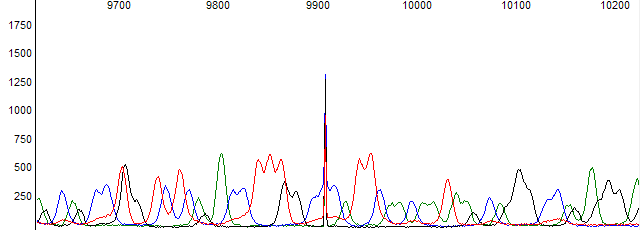One production problem that can occur with Sanger DNA sequencing is sharp spikes in the raw data channel. These spikes can appear anywhere in the raw channel, are very intense and narrow (2 to 5 scans), with signal in all four channels of approximately equal intensity (Figure 1). These spikes are caused by a small gas bubble in the polymer moving past the sequencer’s CCD detector, causing the laser light to be refracted onto the CCD, leading to a sharp spike in raw signal.

Figure 1. Example of a sharp spike caused by a gas bubble.
These spikes are often greater than the real peak signal and their presence can lead to problems basecalling the data. Figure 2 shows an example of what one of these sharp spikes can do to the true peak data. The base at the location of the spike can not be determined and the base ends up being called as a N or mixed base (H in this case).

Figure 2. Result of a sharp bubble spike on the processed trace and basecall.
While these bubble spikes are a production problem that should be solved in the lab, they can be corrected in software using the PeakTrace Basecaller™ (6.12 and higher). Figure 3 shows the same trace file as shown in Figures 1 & 2, but basecalled using PeakTrace 6.12. The spike has been removed with the correct C base peak now clearly visible.

Figure 3. Removal of the bubble spike peak by PeakTrace 6.12.
Pitfalls with using software correction of bubble spikes
While the sharp spikes caused by bubbles can in most cases be corrected in software, it is always best to fix the cause rather than using software to undo the damage. Relying on the basecaller to correct the spikes can result in you missing that you have a production problem. The best way to know if you have a bubble spike problem is to monitor the BUBBLE field of the QualTrace III log file. This field reports the number of strong sharp spikes found in the raw data channel. Significant rates of bubble spikes in production indicate a degassing problem of the polymer and/or buffer and should be corrected.
Conclusion
Sharp spikes are caused by production problems, but they can be corrected using the latest version of the PeakTrace Basecaller. It is important to monitor for the presence of “bubble” spikes by using QualTrace III so that production protocols can be corrected if an issue arises.